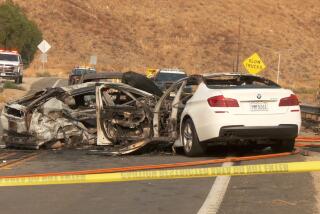Emergency Workers May Fear Cars More Than Bullets
- Share via
CHICAGO — Speeding toward a disabled car on a Chicago expressway, state trooper Mike Karpinski points to a motorist cutting in front of him, apparently oblivious to his cruiser’s flashing emergency lights and blaring siren.
“Look at that,” he said. “You can count on one hand the number of cars that did the right thing” by pulling to the right. “And we just went by, what, 300 cars?”
Karpinski remembers what a training officer told him five years ago: He has a better chance of being struck by a car than a bullet.
“You take your life in your hands out here,” he said.
Consider what has happened in the Chicago area in little more than a month.
On Dec. 23, Chicago Fire Department Lt. Scott Gillen was killed by a car that authorities said roared past flares and emergency lights at the scene of an accident and crushed him against the back of a firetruck.
Days later a Kankakee County sheriff’s deputy was struck and critically injured while helping a tow truck driver on the side of a road. And, in separate incidents in a span of 12 hours, another Chicago firefighter and a paramedic were hit by vehicles.
“It’s definitely getting more dangerous,” Chicago Fire Commissioner James Joyce said. “Drivers are much more in a hurry and much more self-centered. And they’re driving 3,000-pound home entertainment centers with cell phones.”
‘Near-Misses Every Day’
And roads are more crowded than ever--9.4 million registered cars and trucks in Illinois in 1999 compared with 7.9 million 10 years earlier. “We have near-misses every day,” Joyce said.
The story is much the same elsewhere.
“It’s nerve-racking just to get to the scene of a fire,” said Ray Sneed, president of the firefighters union in Washington, D.C. “The community as a whole has gotten to the point where they ignore warning devices the same way they ignore traffic lights.”
Motorists often treat police the way they treat anyone else they think is blocking their way, said Steve MacDonald, spokesman for the Boston Fire Department.
“Sometimes they hit the accelerator or drive over our hoses,” he said.
To protect themselves, emergency crews position their vehicles “so if a drunk comes down the road they will slam into the truck before they slam into you,” MacDonald said. “I’m not sure years ago they had to think of that.”
It is not clear if the problem is getting worse, although some figures suggest it is. Last year, 20 police officers died after being struck by vehicles while outside their squad cars, according to the National Law Enforcement Officers Memorial Fund.
That was twice as high as 1999, but it was the seventh year out of the past century that as many as 20 officers were killed that way.
And fatal accidents are just a fraction of the total involving emergency vehicles. In Illinois alone, 162 state police cars were involved in crashes from January 1998 through December, and 88 were parked with their emergency lights flashing.
State police Sgt. Joe Donley has been hit nine times--once outside his squad car and eight times sitting in it. Not once was his car moving.
“You get to the point no matter how safe you think you are, there are certain things you can’t predict,” said Donley, who would have been at the scene where Gillen was killed had he not been out of state that night. “It could have easily been me or the guys I worked with.”
“I’m amazed by how many troopers are killed strictly in accidents,” said Sgt. Don Birdsong of the Arkansas State Police.
It’s not just emergency vehicles that are at risk. Plowing snow can be particularly treacherous.
“We have big orange trucks with flashing strobe lights all over them, and people are running into the back of them,” Illinois Department of Transportation spokesman Dick Adorjan said. By late January, 45 snowplows had been hit, compared with 39 all last winter, he said.
After a Chicago firefighter was killed last spring by a pickup truck that ran a stop sign and rammed a firetruck, the City Council doubled to $500 the maximum fine for failing to yield to an emergency vehicle. After Gillen’s death in December, the Police Department stepped up its efforts to write those tickets.
“People need to understand when we have the lights on it’s an emergency,” Karpinski said. “It’s not like we turn those on to go get doughnuts.”
More to Read
Sign up for Essential California
The most important California stories and recommendations in your inbox every morning.
You may occasionally receive promotional content from the Los Angeles Times.













